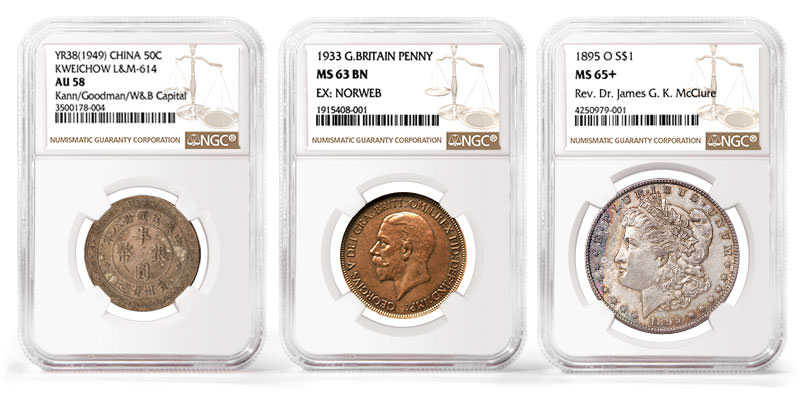藏品系列名稱
「藏品系列名稱」(pedigree)通常用於表明一枚硬幣過去或現在的所有權歸屬。在錢幣學中,就像在藝術品領域一樣,硬幣的來源可能是確定其真實性的重要因素;對一些收藏家而言,如果一枚硬幣曾是知名收藏系列中的藏品,那它就會更具吸引力。
被知名收藏家收藏過的硬幣,其提交者可以要求NGC在認證標籤上註明相關收藏家的名字。NGC必須獲得足夠的證明資料來確認硬幣的系譜,此類證明可能包括:
- 由信譽良好的拍賣行或經銷商所制,並收錄有與所提交硬幣對應圖片的藏品目錄。
- 硬幣在提交時存放於信譽良好的拍賣行或經銷商所提供的密封幣夾或幣盒中,並註明了藏品系列名稱。
NGC藏品系列名稱的構成通常是現在或過去持有人的姓氏字母拼寫,在其後面加上「Collection」(收藏)一詞。針對少數精選藏品系列,NGC的認證標籤中省略了「Collection」一詞。這些藏品包括眾所周知和廣為宣傳的藏品系列,例如Garrett、Eliasberg、Pittman和Norweb藏品等。
硬幣提交者可以要求NGC在認證標籤上註明硬幣為其個人收藏。在絕大多數情況下,藏品系列名稱必須是提交者的姓氏字母拼寫,在其後面加上「Collection」一詞。 注意:如果提交者的姓氏與名人的姓氏相同,則NGC可能會拒絕標註這個系譜,或要求使用提交者姓和名並用。
提交主體如為公司,則該公司可以要求將公司名稱添加到NGC認證標籤中。通常情況下NGC不會在藏品系列名稱中加入公司的名字,除非該公司直接提出此項要求。
NGC有時會添加一個藏品系列名稱,以標示硬幣是聚藏裏的一部分,又或是來自某個造幣廠發行的特定套裝。NGC也會用藏品系列名稱標示某一活動(例如貿易展會),或是對硬幣提供其他識別資訊。

在大多數情況下,藏品系列名稱出現在NGC認證標籤中硬幣等級的下方,包含一行或兩行內容。除了來自於某些重大沉船或聚藏的硬幣外,NGC統計中通常不會按藏品系列名稱來單獨列出硬幣,而是將硬幣列入NGC統計的常規欄目列表中。
NGC對系譜的確定和認證擁有獨立的自由裁量權。如果NGC認為某一藏品系列名稱會與其他藏品系列名稱混淆,則可不予認可該藏品系列名稱。如果NGC決定對相關藏品系列名稱不予認證,評級費及服務費恕不退還。NGC將盡全力確保藏品系列名稱的準確性,但是藏品系列名稱的歸屬不包含在NGC保證的承諾範圍內。
常見問題
如何申請將藏品系列名稱加到NGC認證標籤上?
如果您希望藏品系列名稱被標註到NGC認證標籤,請在NGC提交表格上清楚寫明以此要求。請務必清晰指出藏品系列名稱要求適用於提交表中的哪些硬幣:所有硬幣、還是僅針對部分硬幣。也請提供任何有助NGC確認藏品系列名稱的證明。
識別及標註硬幣的藏品系列(包括您自己的收藏系列)沒有額外收費。已被NGC評級封存的硬幣如欲添加藏品系列名稱,可以選用合適的專稱複審(Designation Review)服務重新提交。
NGC全權決定承認及標註識別藏品系列名稱與否。如果NGC對藏品系列名稱存有疑惑,即可不予標識。如果NGC不承認藏品系列名稱並決定不作標註識別,評級費及服務費恕不退還。
藏品系列名稱是否能增加硬幣的價值?
如果硬幣屬知名收藏系列,它可能會溢價出售或更受追捧,但這取決於硬幣本身、藏品系列和市場的各方面情況。許多藏品系列名稱並不會增加硬幣的價值。在購買之前,應充分了解相關藏品系列名稱的意思,並搜查硬幣的價值。
在NGC統計中,硬幣會按照藏品系列名稱被單獨列出嗎?
除了某些來自知名船骸、聚藏和造幣廠套裝的硬幣系列外,NGC統計中一般不會按藏品系列名稱來收錄硬幣,而是將硬幣列入NGC統計列表的常規欄目中。
「收藏」(collection) 和「聚藏」(hoard) 之間有什麼分別?
收藏與聚藏之間並沒有一條被廣泛認同的明顯界線。 NGC認為收藏是指一組硬幣被收藏者有選擇性地收集組合起來,而聚藏則指累積大量硬幣,通常會有許多完全相同款式的。
例如「Redfield Hoard」,是LaVere Redfield聚藏了總共約四十萬枚1美元銀幣的系列名稱。同樣,「GSA Hoard」是指在1973年至1980年間,聚藏於美國財政部金庫中的數百萬枚1美元銀幣,後來它們經總務管理局(GSA)售出。
當一枚硬幣的藏品系列名稱是標註某展銷會或類似的活動時,這意味著什麼?
NGC有時候會把展銷會的名稱作為藏品系列名稱標註在標籤上,以作紀念;這並不代表這些硬幣是購於該展銷會。例如,這類的標註是用於在展銷會中派發的樣品,或是參展經銷商在展銷會中發售的硬幣。一般而言,只有指定的批量提交或由NGC準備的樣品才會有這類的標註。
請勿混淆這些展銷會標註與NGC的「Show Releases」(展會發行)專稱。展會發行是包含「Releases」(發行)一詞的特殊專稱。了解更多有關NGC展會發行的特殊標籤,請點擊此處。
除了藏品系列和展銷會名稱,NGC還使用哪些藏品系列名稱?
在大多數情況下,藏品系列名稱用於識別硬幣的過去或現在的擁有人,或用於紀念某活動。有時候,NGC也會用來提供其他的識別資訊。例如,首次遇到一枚屬於新發現版別的硬幣時,該硬幣或會在NGC認證標籤上被標註為「Discovery Coin」。
甚麼情況下合資格的硬幣可獲標示為某造幣廠的特別發行系列,作為其藏品系列名稱,例如「鷹揚銀幣25週年系列」?
只要硬幣毫無疑問是作為某造幣廠的特別套幣裝的一部分發行的,NGC有時候會標示這些硬幣為某造幣廠的特別發行系列,作為其的藏品系列名稱。
以2011年美國鷹揚銀幣的「25週年系列」(25TH ANNIVERSARY SET)為例,它們是美國造幣廠於美國鷹揚銀幣25週年五枚套裝中發行的。另外,也有些是與「25週年鷹揚銀幣系列」的套裝分開發行的。因此,只有在完好無損的25週年鷹揚銀幣套裝的美國造幣廠原廠包裝及運輸盒內被送到NGC的硬幣才會有「25週年系列」(25TH ANNIVERSARY SET)的藏品系列名稱。
某些情況下,硬幣只需在造幣廠的原廠包裝中送抵NGC,而不需要被封在完好、未開封的美國造幣廠運輸盒之中,以獲得特定的系列名稱作為其藏品系列名稱。這樣的情況一般是當套幣的包裝是一經開封或篡改後,便會留下無可掩飾的跡象的類型。此外,如該款硬幣只有於套幣裝中被發行,便不需要在原廠的包裝中被提交。
重要提示: NGC全權決定是否認可並標註某套裝系列名稱作為其藏品系列名稱;也並非所有的系列名稱都可以被識別並標示在NGC標籤上。因此,除非在NGC網站上已經發布文章公佈相關指引,否則我們建議提交人士在要求我們加上某個系列藏品系列名稱前,先聯絡NGC客戶服務部門 確認硬幣是否符合資格以及相關的提交要求。
如果NGC認證標籤上預先印有藏品系列名稱(Pedigree),那麼該藏品系列名稱(Pedigree)是否還會被標註於硬幣描述中?
如何申請將硬幣的重量與直徑添加至NGC認證標籤?
藏品系列名稱是否也享有NGC保證?
NGC將盡力確保所識別的藏品系列名稱的準確性,但NGC保證並不覆蓋藏品系列名稱的識別。